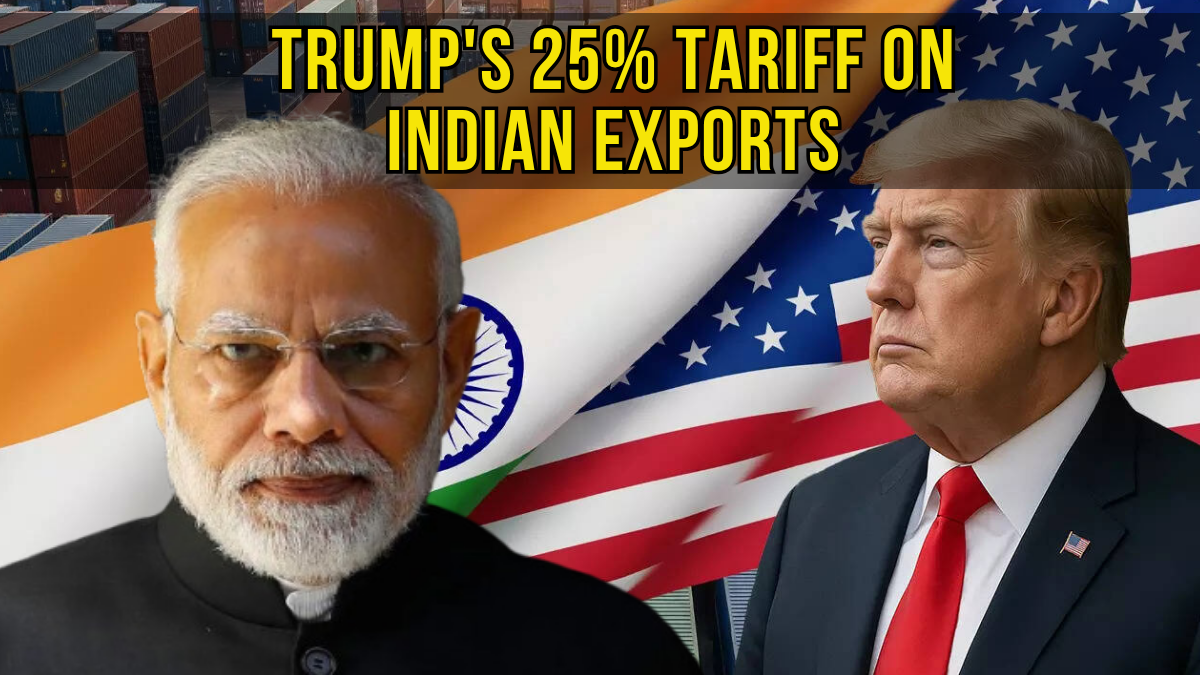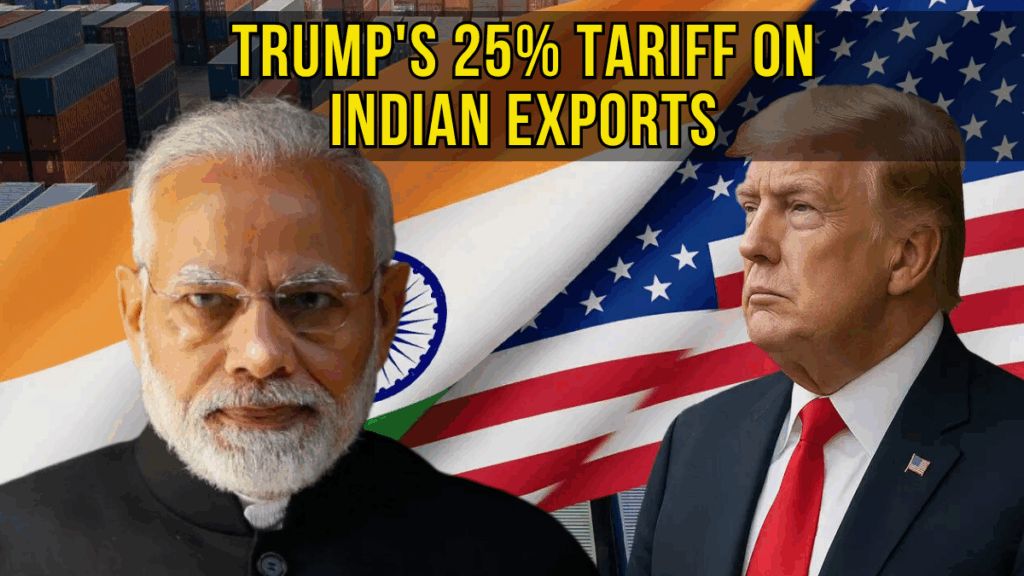As tensions rise over trade between the United States and India, former U.S. President Donald Trump has announced a 25% tariff on Indian exports. However, Indian government sources have clarified that this move will have only a negligible effect on the Indian economy, with the GDP impact not expected to exceed 0.2% in the fiscal year 2024–25.

Despite the potential impact on trade negotiations, the Indian government has emphasized its commitment to national interest, particularly protecting sensitive sectors like agriculture, dairy, and MSMEs.
Summary Table: Trump’s 25% Tariff on Indian Exports
Key Information |
Details |
|---|---|
Tariff Imposed By |
Donald Trump (former U.S. President) |
Tariff Percentage |
25% |
Expected GDP Impact |
0.2% of GDP or approx Rs 66,136 crore (based on Rs 330.68 lakh crore GDP) |
India’s FY 2024–25 Nominal GDP |
Rs 330.68 lakh crore |
India-US Bilateral Trade Value (2024–25) |
$132 billion |
India’s Export Value to US (2024–25) |
$86.51 billion |
India’s Import Value from US (2024–25) |
$45.33 billion |
Final Trade Deal Timeline |
Expected by September or October 2025 |
Official Site |
India’s Response: Economy Can Absorb the Tariff Impact
Sources within the Indian government told NDTV that the proposed tariff’s effect would be minimal. They estimated a 0.2% drop in GDP, calling it “manageable.” Bloomberg analysts echoed this view, suggesting a slowdown of only 0.3%. The 0.2% loss translates to approximately Rs 66,136 crore, based on India’s nominal GDP for FY 2024–25 of Rs 330.68 lakh crore.
This means that while the tariff may affect a few sectors, the broader economy remains strong enough to absorb the shock.
Government Stands Firm: No Concessions on Sensitive Sectors
In the face of rising pressure, Indian officials reiterated that they will not bow to external demands, especially those that could negatively affect the domestic population. This includes:
- Agriculture and dairy markets, which are price-sensitive and politically significant
- Import restrictions on beef and “non-veg milk” (milk from cows fed animal-based products)
- Genetically modified (GM) crops, which are not permitted for import due to potential harm to farmer interests
Officials confirmed that India’s policy decisions are guided by religious sentiments, food safety standards, and national priorities, not external political pressure.
Farmers: A Non-Negotiable Stakeholder
Agriculture in India may contribute less than 20% to GDP, but its social and political importance cannot be overstated. Nearly 50% of India’s 144 crore population is either directly or indirectly employed in agriculture and allied sectors. This makes it a core vote bank for any ruling party.
India’s firm stance on not opening up to foreign agricultural products stems from this demographic sensitivity. The 2021 rollback of the farm laws, following nationwide protests, highlighted how politically charged this sector is.
The Root of the Tariff: Stalled Trade Deal Talks
Trump’s announcement of the tariff stems from deadlocked negotiations between the two countries over a bilateral trade agreement. The deal has been in the works since November 2024, but talks have stalled because of US demands that would:
- Allow American farmers and dairy producers to access Indian markets
- Introduce GM crops and dairy practices into India, which India has consistently opposed
Trump’s frustration was apparent when he said:
“India has been a good friend… but has charged basically more tariffs than almost any other country… you just can’t do that.”
India-US Trade: By the Numbers
Despite tensions, the United States remains India’s largest trading partner, a status it has held for four consecutive years.
Bilateral Trade Figures for 2024–25:
- Total Bilateral Trade: $132 billion
- Exports to the US: $86.51 billion (up 11.6% from the previous year)
- Imports from the US: $45.33 billion (up from $42.2 billion in 2023–24)
These figures show a strong trade relationship that both countries are unlikely to jeopardize over political rhetoric.
Tariff Review May Follow Final Deal
Sources have indicated that negotiations are still underway, and a final interim trade deal is likely to be announced by September or October. Once that deal is signed:
- The 25% tariff may be reviewed
- A structured dialogue between the two governments is expected to resume
There had been initial hope that the tariff issue could be resolved before the August 7 implementation date, but that now seems unlikely.
US Tariff: A Political Move?
Experts believe the tariff is less about economics and more about political posturing in the lead-up to the U.S. presidential elections. Trump has often criticized India’s high tariffs, calling them:
“Among the highest in the world”
“Obnoxious and strenuous non-monetary trade barriers”
His focus on India’s military and energy ties with Russia, as well as agriculture policies, seems aimed at strengthening his America First agenda among domestic voters.
India’s Trade Strategy: A Look Ahead
Despite the setback, India continues to focus on expanding trade ties with the US, EU, and other global partners. The government has made clear that:
- Trade must support domestic industries, especially MSMEs
- Tariff reforms will be reciprocal and strategic, not reactionary
- WTO norms and bilateral diplomacy will guide decisions
India is also actively exploring alternative export markets and regional trade blocs to diversify its trade dependencies.
FAQs About Trump’s 25% Tariff on Indian Exports
Q1. Will the 25% US tariff on Indian exports impact India’s economy significantly?
Ans. o. The estimated GDP impact is around 0.2%, which the Indian government considers negligible and manageable.
Q2. Why did Donald Trump impose this tariff?
Ans. The tariff is linked to stalled trade deal talks. The US wants access to India’s agriculture and dairy markets, which India has refused.
Q3. Will India change its stance on agriculture and dairy imports?
Ans. No. India has categorically stated it will not allow imports that hurt domestic farmers or offend religious sentiments.
Q4. Is the trade deal between India and the US still happening?
Ans. Yes. Talks are ongoing, and an interim deal is expected by September or October 2025.
Q5. What was the total trade value between India and the US in 2024–25?
Ans. It was $132 billion, with India exporting goods worth $86.51 billion to the US.
Conclusion
While Donald Trump’s proposed 25% tariff on Indian exports has sparked media buzz, its actual impact on India’s economy is expected to be minimal. The Indian government has signaled a clear intent to protect national interests, especially in agriculture and MSMEs, and not cave to external pressures. Meanwhile, trade negotiations with the US continue, and both sides appear committed to finding common ground.
For official updates on India’s international trade policy, visit the Ministry of Commerce and Industry.
Click Here For More


